七年级英语下册(沪教版)思维导图
沪教版(上海)-初中数学七年级、八年级、九年级数学全册章节知识点结构思维导图集
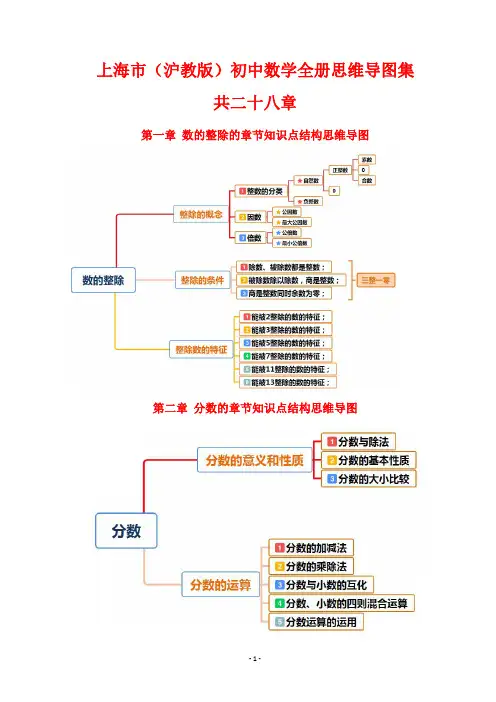
- 14 -
第二十六章 二次函数的章节知识点结构思维导图 第二十七章 圆与正多边形的章节知识点结构思维导图
- 15 -
第二十八章 统计初步的章节知识点结构思维导图
- 16 -
-7-
第十四章 三角形的章节知识点结构思维导图 第十五章 平面直角坐标系的章节知识点结构思维导图
-8-
上海市(沪教版)八年级数学全册章节思维导图 共八个章节
第十六章 二次根式的章节知识点结构思维导图
-9-
第十七章 一元二次方程的章节知识点结构思维导图
- 10 -
第十八章 正比例函数和反比例函数的章节知识点结构思维导图 第十九章 几何证明的章节知识点结构思维导图
-3-
第七章 线段与角的画法的章节知识点结构思维导图 第八章 长方体的再认识的章节知识点结构思维导图
-4-
上海市(沪教版)七年级数学全册章节思维导图 共七章
第九章 整式的章节知识点结构思维导图
-5-
第十章 分式的章节知识点结构思维导图 第十一章 图形的运动的章节知识点结构思维导图
-6-
第十二章 实数的章节知识点结构思维导图 第十三章 相交线 平行线的章节知识点结构思维导图
- 11 -
第二十章 一次函数的章节知识点结构思维导图 第二十一章 代数方程的章节知识点结构思维导图
- 12 -
第二十二章 四边形的章节知识点结构思维导图 第二十三章 概率初步的章节知识点结构思维导图
- 13 -
上海市(沪教版)ቤተ መጻሕፍቲ ባይዱ年级数学全册章节思维导图 共五章
第二十四章 相似三角形的章节知识点结构思维导图
上海市(沪教版)初中数学全册思维导图集 共二十八章
初一英语unit7思维导图沪教版
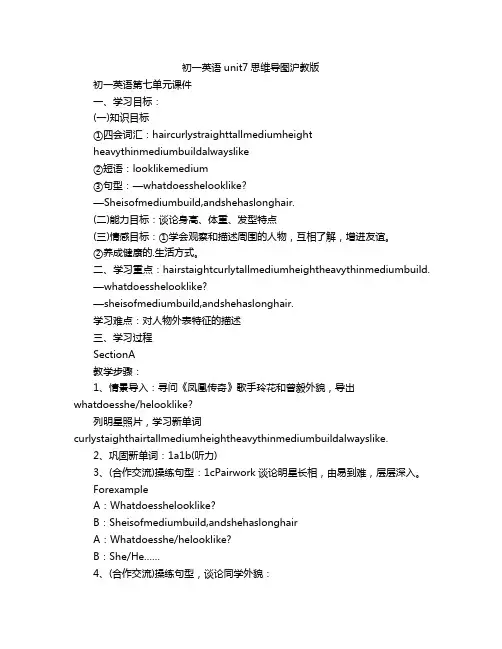
初一英语unit7思维导图沪教版初一英语第七单元课件一、学习目标:(一)知识目标①四会词汇:haircurlystraighttallmediumheightheavythinmediumbuildalwayslike②短语:looklikemedium③句型:—whatdoesshelooklike?—Sheisofmediumbuild,andshehaslonghair.(二)能力目标:谈论身高、体重、发型特点(三)情感目标:①学会观察和描述周围的人物,互相了解,增进友谊。
②养成健康的.生活方式。
二、学习重点:hairstaightcurlytallmediumheightheavythinmediumbuild.—whatdoesshelooklike?—sheisofmediumbuild,andshehaslonghair.学习难点:对人物外表特征的描述三、学习过程SectionA教学步骤:1、情景导入:寻问《凤凰传奇》歌手玲花和曾毅外貌,导出whatdoesshe/helooklike?列明星照片,学习新单词curlystaighthairtallmediumheightheavythinmediumbuildalwayslike.2、巩固新单词:1a1b(听力)3、(合作交流)操练句型:1cPairwork谈论明星长相,由易到难,层层深入。
ForexampleA:Whatdoesshelooklike?B:Sheisofmediumbuild,andshehaslonghairA:Whatdoesshe/helooklike?B:She/He……4、(合作交流)操练句型,谈论同学外貌:A:WhatdoeswangLin/……looklike?B:She/He……5、练习听力:(自主探究)2a、2b,ListenandfillDavid.sallyandpete’slooks.6、(合作交流,拓展创新)课本Part3谈论一下你朋友的相貌衣着7、(合作交流,拓展创新)Freetalk自由谈论明星相貌衣着(分组讨论、组长报告)8、阅读训练(猜一猜,他是谁)9、树立健康生活理念(讨论不健康的人群)10、播放健康歌Let’splaysports!11、课后达标检测(1)她长得什么样:Whatdoesshe?(2)他又高又瘦,头发又直又短:Heisand,hehasshortandhair.(3)她又矮又胖,头发又长又卷。
牛津新沪教版初中英语七年级下册Unit5 Water 词汇 精品课件(共28张PPT)
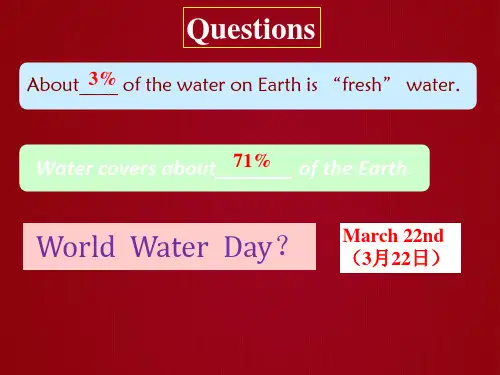
“A few days ago, I was in a cloud,” said the drop of water. “ Then I dropped into a river and ran into a reservoir. Then it was time for people to clean me.” “Clean you?” Dora asked. “Yes, I was dirty. They cleaned me and added some chemicals
pollute me. I’m valuable.”
不要让最后一滴水
成为眼泪!
Dora asked, “So is this the end of your journey?” “No. People will make me clean again. I’ll go into a river and then into the “Again?” sea again.”
“Yes. My journey starts there. Remember not to waste or
f oto r go (we)
It is time for to school.
(go)
Part4 Text
Dora was in the bathroom. The tap was on. (adv) “Turn that tap off,” said an angry voice.“”You’re wasting water.” Dora looked around, but there was no one there. “Who are you?” “I’m a drop of water. from?” Do you know where I come
沪教版(上海市) 初中数学思维导图 七年级数学全册章节思维导图集
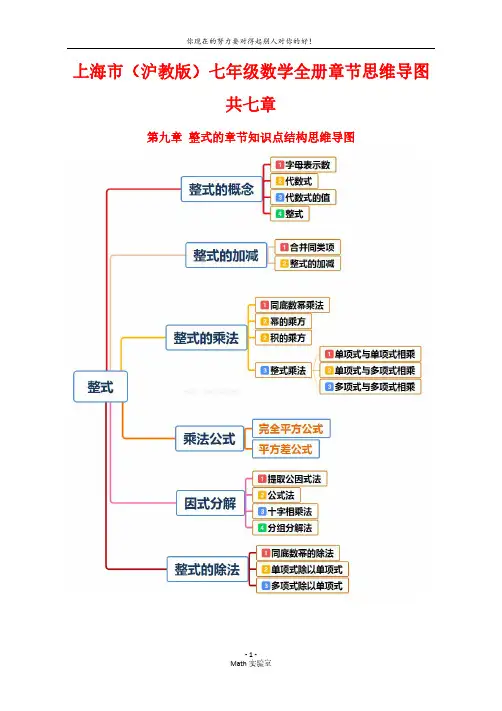
-5Math 实验室
你现在的努力要对得起别人对你的好!
第十九章 几何证明的章节知识点结构思维导图
-6Math 实验室
你现在的努力要对得起别人对你的好!
第二十章 一次函数的章节知识点结构思维导图
第二十一章 代数方程的章节知识点结构思维导图
-7Math 实验室
第十二章 实数的章节知识点结构思维导图
第十三章 相交线 平行线的章节知识点结构思维导图
-3Math 实验室
你现在的努力要对得起别人对你的好!
第十四章 三角形的章节知识点结构思维导图
第十五章 平面直角坐标系的章节知识点结构思维导图
-4Math 实验室
你现在的努力要对得起别人对你的好!
第十六章 二次根式的章节知识点结构思维导图 第十七章 一元二次方程的章节知识点结构思维导图
第二十七章 圆与正多边形的章节知识点结构思维导图
-9Math 实验室
你现在的努力要对得起别人对你的好!
第二十八章 统计初步的章节知识点结构思维导图
- 10 Math 实验室
你现在的努力要对得起别人对你的好!
上海市(沪教版)七年级数学全册章节思维导图 共七章
第九章 整式的章节知识点结构思维导图
-1Math 实验室
你现在的努力要对得起别人对你的好!
第十章 分式的章节知识点结构思维导图
第十一章 图形的运动的章节知识点结构思维导图
-2!
你现在的努力要对得起别人对你的好!
第二十二章 四边形的章节知识点结构思维导图
第二十三章 概率初步的章节知识点结构思维导图
第二十四章 相似三角形的章节知识点结构思维导图
-8Math 实验室
沪教版英语七年级下册知识点归纳
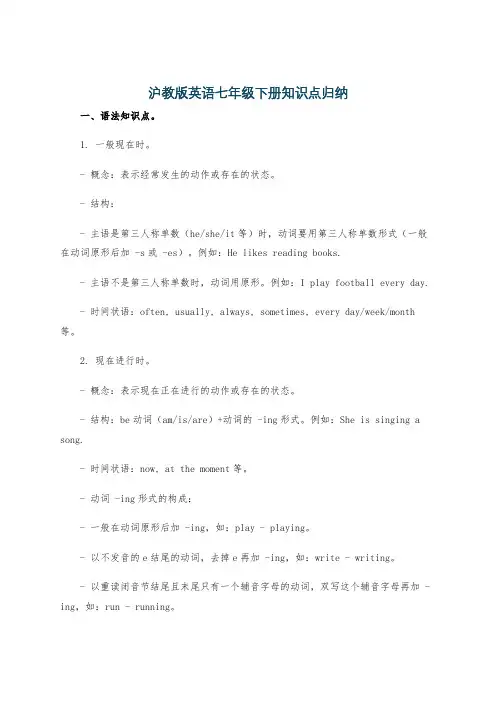
沪教版英语七年级下册知识点归纳一、语法知识点。
1. 一般现在时。
- 概念:表示经常发生的动作或存在的状态。
- 结构:- 主语是第三人称单数(he/she/it等)时,动词要用第三人称单数形式(一般在动词原形后加 -s或 -es)。
例如:He likes reading books.- 主语不是第三人称单数时,动词用原形。
例如:I play football every day.- 时间状语:often, usually, always, sometimes, every day/week/month 等。
2. 现在进行时。
- 概念:表示现在正在进行的动作或存在的状态。
- 结构:be动词(am/is/are)+动词的 -ing形式。
例如:She is singing a song.- 时间状语:now, at the moment等。
- 动词 -ing形式的构成:- 一般在动词原形后加 -ing,如:play - playing。
- 以不发音的e结尾的动词,去掉e再加 -ing,如:write - writing。
- 以重读闭音节结尾且末尾只有一个辅音字母的动词,双写这个辅音字母再加 -ing,如:run - running。
3. 形容词的比较级和最高级。
- 比较级:- 构成:- 一般在形容词原级后加 -er,如:tall - taller。
- 以e结尾的形容词,加 -r,如:nice - nicer。
- 以重读闭音节结尾且末尾只有一个辅音字母的形容词,双写这个辅音字母再加-er,如:big - bigger。
- 多音节形容词和部分双音节形容词,在原级前加more,如:beautiful - more beautiful。
- 用法:用于两者之间的比较,常用结构为“A+be+比较级+than + B”,例如:This book is more interesting than that one.- 最高级:- 构成:- 一般在形容词原级后加 -est,如:tall - tallest。
七年级下册英语全册思维导图
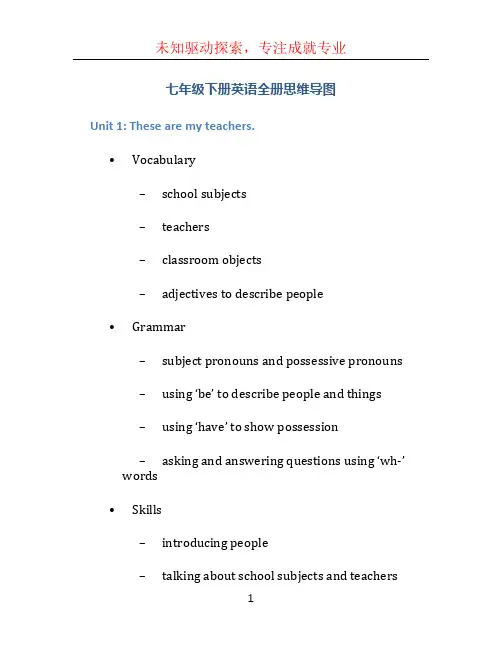
七年级下册英语全册思维导图Unit 1: These are my teachers.•Vocabulary–school subjects–teachers–classroom objects–adjectives to describe people•Grammar–subject pronouns and possessive pronouns–using ‘be’ to describe people and things–using ‘have’ to show possession–asking and answering questions using ‘wh-’ words•Skills–introducing people–talking about school subjects and teachers–describing people–asking and answering questions about possessionUnit 2: This is my school.•Vocabulary–places in a school–prepositions of place–numbers 1-1000–adverbs of frequency•Grammar–using ‘there is’ and ‘there are’–using the verb ‘have’ with objects and rooms–using prepositions to describe location–forming questions with ‘where’ and giving answers•Skills–talking about your school–giving directions in a school–describing locations–asking and answering questions about places Unit 3: How do you study for a test?•Vocabulary–school activities and supplies–adverbs of manner–adjectives to describe actions–time expressions•Grammar–using present simple tense to talk about routines and habits–using adverbs of manner to describe how things are done–using adjectives to describe actions–using time expressions to talk about frequency •Skills–talking about daily routines–discussing how to study for a test–describing actions using adjectives–expressing frequency using adverbsUnit 4: I love learning English!•Vocabulary–adjectives describing feelings–types of music–activities–opinions•Grammar–using present continuous tense to talk about actions happening now–using ‘like’, ‘love’, ‘enjoy’ to talk about hobbies and activities–using adjectives to describe feelings–expressing opinions using ‘I think’, ‘I believe’•Skills–talking about hobbies and activities–expressing likes and dislikes–describing feelings–giving opinionsUnit 5: How’s the weather?•Vocabulary–weather conditions–seasons–types of clothing•Grammar–using present simple tense to talk about weather–using ‘it’ to refer to the weather–using prepositional phrases to describe weather conditions•Skills–talking about the weather–describing seasons and clothing–making predictions about the weather–giving weather forecastsUnit 6: What’s your favorite day?•Vocabulary–days of the week–activities–ordinal numbers–adjectives to describe activities•Grammar–using ‘what’ to ask about favorite things–using ordinal numbers to talk about the order of days–using adjectives to describe activities •Skills–talking about favorite activities–discussing daily routines on different days–using ordinal numbers–describing activities using adjectivesUnit 7: I want to be a basketball player.•Vocabulary–jobs–sports–school subjects related to jobs–adjectives to describe jobs•Grammar–using ‘want to’ to talk about future plans–using ‘be going to’ to talk about future intentions–using adjectives to describe jobs–using ‘because’ to give reasons•Skills–talking about future plans and intentions–discussing different jobs–describing jobs using adjectives–giving reasons using ‘because’Unit 8: Where’s the post office?•Vocabulary–places in a city–directions–prepositions of movement–adjectives to describe cities•Grammar–using ‘Can you…’ to ask for help–using imperatives to give instructions–using prepositions of movement to give directions–using ‘there is’ and ‘there are’ to talk about places in a city•Skills–asking for and giving directions–describing places in a city–using imperatives to give instructions–talking about different citiesUnit 9: How do you make a banana smoothie?•Vocabulary–food and drinks–kitchen utensils–imperatives for cooking–adjectives to describe food and taste •Grammar–using imperatives to give instructions for cooking–using ‘how much’ and ‘how many’ to ask about quantities–using adjectives to describe food and taste–using ‘like’ to express preferences•Skills–talking about cooking and food preferences–giving instructions for making a recipe–describing food and taste–asking about quantitiesUnit 10: I’m watching TV.•Vocabulary–activities–types of TV programs–time expressions–adjectives to describe TV programs •Grammar–using present continuous tense to talk about actions happening now未知驱动探索,专注成就专业–using adjectives to describe TV programs–using time expressions to talk about frequency •Skills–discussing TV programs and activities–talking about what is happening now–describing TV programs using adjectives–expressing frequency of activities11。
英语学习:人教版七年级下册各单元思维导图
英语学习:人教版七年级下册各单元思维导图Unit 1: My School Life- Vocabulary:- Classroom objects- School subjects- Grammar:- Simple present tense- Plural forms of nouns- Speaking:- Talking about school facilities- Describing school subjects and preferences- Listening:- Understanding class schedules- Following instructions in the classroomUnit 2: Hobbies- Vocabulary:- Leisure activities- Sports and games- Grammar:- Present continuous tense- Adverbs of frequency- Speaking:- Talking about hobbies and interests- Discussing preferences and dislikes- Listening:- Understanding conversations about hobbies- Following instructions for games and activitiesUnit 3: At Home- Vocabulary:- Rooms and furniture- Daily routines- Grammar:- Present simple tense- Prepositions of place- Speaking:- Describing rooms and houses- Talking about daily routines- Listening:- Understanding conversations about household chores - Following instructions for recipes and tasksUnit 4: Food and Drink- Vocabulary:- Types of food and drinks- Quantifiers- Grammar:- Countable and uncountable nouns- How much/How many- Speaking:- Talking about food preferences- Ordering food at a restaurant- Listening:- Understanding conversations about meals and recipes - Following instructions for cooking and servingUnit 5: Family and Friends- Vocabulary:- Family members- Personal pronouns- Grammar:- Possessive adjectives- Wh-questions- Speaking:- Introducing family members- Describing relationships- Listening:- Understanding conversations about family activities- Following instructions for interviews and introductionsUnit 6: At the Zoo- Vocabulary:- Animals and their characteristics- Adjectives to describe animals- Grammar:- There is/are- Speaking:- Talking about animals and their habitats- Listening:- Understanding conversations about zoo visits - Following directions for finding animalsUnit 7: The Weather- Vocabulary:- Weather conditions- Seasons and months- Grammar:- Present continuous for future arrangements - Adjectives to describe weather- Speaking:- Talking about weather in different seasons - Making plans based on weather forecasts- Listening:- Understanding weather reports- Following instructions for outdoor activitiesUnit 8: Holidays- Vocabulary:- Festivals and celebrations- Holiday activities- Grammar:- Past simple tense- Time expressions- Speaking:- Talking about past holidays and celebrations- Describing holiday traditions- Listening:- Understanding conversations about holiday experiences - Following instructions for crafts and gamesUnit 9: Around Town- Vocabulary:- Places in a city- Directions and locations- Grammar:- Imperatives- Giving and following directions- Speaking:- Asking for and giving directions- Describing places in a city- Listening:- Understanding conversations about city attractions - Following directions to different locationsUnit 10: Health and Fitness- Vocabulary:- Body parts and health issues- Sports and exercises- Grammar:- Present continuous for future arrangements- Imperatives for instructions- Speaking:- Talking about health and fitness routines- Giving advice on healthy habits- Listening:- Understanding conversations about health problems - Following instructions for exercises and workouts。
英语(沪教版)教材分析 七年级下册
2
What is this paragraph mainly about? Why does the writer think raising pet dogs is a good idea? How will the story go on? What does the pronoun “this” in line 4 refer to?。
While-reading
3
What does the passage tell us? Will such things in the passage happen in the future? Why do you think so? What can you learn from the story? Why does the writer write
9 What can we do on that day?
10 Does your mother really want you presents like flowers or cards? I think you can do more. Please read the
third paragraph and find out what other special gifts you can give to them.
2 A lot of people like travelling in France. How much do you know about it? What do tourists like doing there?
3 Take a look at the title of the passage. Which does the word “call” mean in the title?
沪教版七年级英语Unit3.ppt
练习
1. There is an English dictionary on the table. (变复数) There are English dictionaries on the table. 2. There are many people in the street. (一般疑问句) Are there many people in the street? 3. There are a lot of students in the fileds. (一般疑问句) Are there a lot of students in the files? 4. There is an apple on the desk. (特殊疑问句) How many apples on the desk?
重要短语
1) Stop doing something/ stop to do something Tom stops doing homework. 汤姆停止做作业。 Stop doing=停止做什么 Tom stops to do homework. 汤姆停下手头的活去做作业了S。top to do=停止…去做…
不可数名词
最常见的不可数名词
Advice(建议), baggage(行李), change(零钱), furniture (家具), hair(头发), homework(回家作 业), information(信息), knowledge(知识), luggage (行李),money(钱),news(消息),progress(进 步),traffic(交通),fun(乐趣),weather(天气),music (音乐),Health(健康),luck(好运),water(水),time (时间),rain(雨),truth(真相),ice(冰)
英语学习辅助:七年级下册各单元思维导图(人教版)
英语学习辅助:七年级下册各单元思维导图(人教版)Unit 1: My Day- Vocabulary: Daily routine, actions, time expressions- Grammar: Simple present tense, adverbs of frequency- Listening: Listening to and understanding daily routines- Speaking: Describing daily routines and habits- Reading: Reading about daily routines of different people- Writing: Writing a paragraph about one's daily routineUnit 2: I Love Sports- Vocabulary: Sports and related words- Grammar: Present continuous tense, imperatives- Listening: Listening to sports-related conversations- Speaking: Talking about sports preferences and abilities- Reading: Reading about different sports and their rules- Writing: Writing a short paragraph about one's favorite sportUnit 3: At a Party- Vocabulary: Party-related words, food and drinks- Grammar: Present continuous tense, countable and uncountable nouns- Listening: Listening to conversations at a party- Speaking: Describing a party and expressing preferences- Reading: Reading about different party activities- Writing: Writing an invitation to a partyUnit 4: Our School Life- Vocabulary: School subjects, school facilities- Grammar: Present simple tense, questions and answers- Listening: Listening to conversations about school life- Speaking: Talking about school subjects and activities- Reading: Reading about school life in different countries- Writing: Writing a short paragraph about one's school lifeUnit 5: My Family- Vocabulary: Family members, adjectives to describe family members- Grammar: Possessive adjectives, possessive 's- Listening: Listening to conversations about family members- Speaking: Describing family members and their relationships- Reading: Reading about different types of families- Writing: Writing a short paragraph about one's familyUnit 6: Our Neighborhood- Vocabulary: Places in a neighborhood, directions- Grammar: Prepositions of place, there is/are- Listening: Listening to conversations about places in a neighborhood- Speaking: Giving directions and talking about one's neighborhood - Reading: Reading about different places in a city- Writing: Writing a short paragraph about one's neighborhoodUnit 7: Healthy Habits- Vocabulary: Health-related words, healthy habits- Grammar: Should/shouldn't, imperatives- Listening: Listening to conversations about health habits- Speaking: Talking about healthy habits and giving advice- Reading: Reading about healthy lifestyles- Writing: Writing a short paragraph about one's healthy habits Unit 8: My Hobbies- Vocabulary: Hobbies and leisure activities- Grammar: Present simple tense, adverbs of frequency- Listening: Listening to conversations about hobbies- Speaking: Talking about hobbies and free time activities- Reading: Reading about different hobbies and interests- Writing: Writing a short paragraph about one's favorite hobby以上是七年级下册各单元思维导图的简要内容说明。
